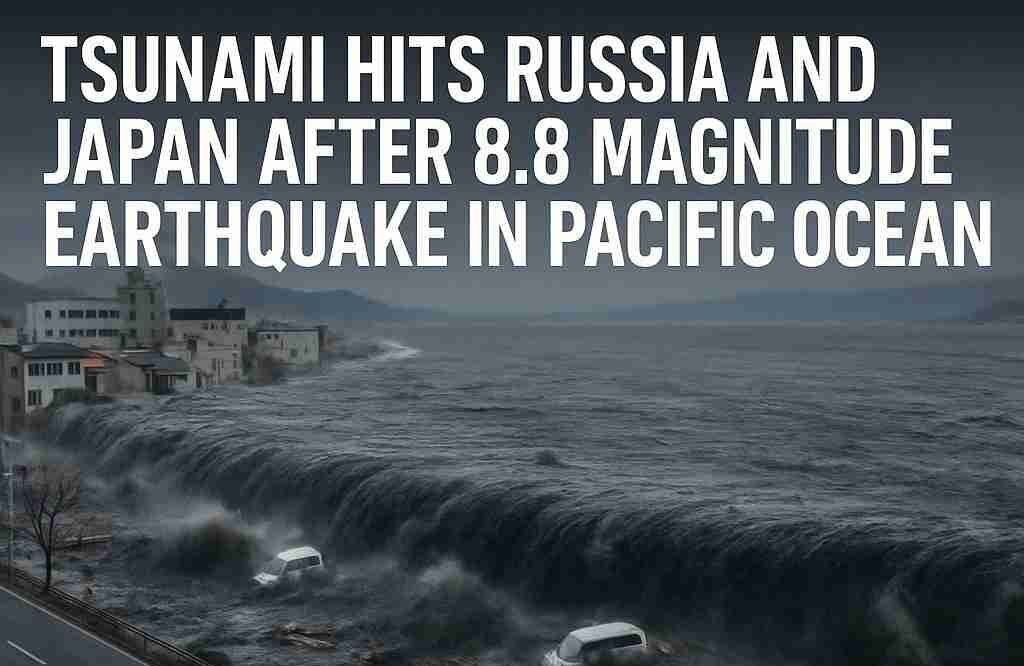Strongest Earthquake Since 2011 Triggers Tsunami Warnings Across Pacific, Including Hawaii, Alaska, and New Zealand
A powerful 8.8 magnitude earthquake struck Russia’s Far East early Wednesday, triggering a massive tsunami in the northern Pacific. This earthquake is the strongest to hit the region since 2011 and has prompted tsunami warnings for coastal regions in Hawaii, Alaska, Japan, and even New Zealand. The tremor has caused damage in areas near the epicenter, while evacuation measures have been implemented in various locations.
Key Details of the Earthquake and Tsunami:
- Magnitude & Location: The earthquake, registering 8.8 in magnitude, struck off the Kamchatka Peninsula, Russia’s Far East, with aftershocks measuring up to 6.9. It occurred at a depth of 13 miles (20.7 km).
- Tsunami Alerts: The Pacific Tsunami Warning Center issued urgent warnings for Alaska, Hawaii, and parts of the South Pacific, including New Zealand, due to the quake’s massive impact.
Impact on Affected Regions:
Russia and Kamchatka Peninsula:
- Initial Impact: The first tsunami wave hit the Kuril Islands, with residents evacuating to higher ground. There were reports of building damage in Petropavlovsk-Kamchatsky, but no fatalities or major injuries were reported.
- Evacuations & Damage: Local officials confirmed that some buildings swayed, and mobile services were temporarily disrupted. Residents in the affected regions were urged to stay in safe areas due to possible aftershocks.
Japan:
- Tsunami Waves in Hokkaido: The Japan Meteorological Agency reported a 40-centimeter (1.3-foot) wave in Tokachi, Hokkaido. Ferries and trains in northern Japan were temporarily suspended due to the tsunami alert.
- Nuclear Safety: No abnormalities were detected in Japan’s nuclear plants, including the Fukushima Daiichi plant, where staff were moved to higher ground as a precaution.
Hawaii & the Pacific Coast:
- Honolulu Evacuations: Tsunami warning sirens blared in Honolulu, prompting residents to seek higher ground. While the waves were not expected to be massive, authorities urged caution due to strong currents.
- Wave Height Estimates: Smaller tsunami waves were expected along the West Coast of the United States, including Oregon, California, and British Columbia, with wave heights between 1-2 feet (30-60 cm).
New Zealand & South Pacific:
- Warnings Issued: New Zealand authorities issued alerts for unusual currents and potential surges along the coast. Citizens were advised to stay away from beaches, harbors, and estuaries as a precaution.
- Philippine Warnings: The Philippine Institute of Volcanology and Seismology also warned that small tsunami waves might affect the archipelago’s eastern coast, urging people to avoid the water.
Aftershock Risks & Global Response:
- Aftershocks Expected: Experts are monitoring the region closely for aftershocks, which could continue for weeks. The earthquake is the most powerful in the Kamchatka Peninsula since 1952, and the region is still at risk for aftershock events.
- International Monitoring: The U.S. Geological Survey (USGS) and local seismologists continue to track seismic activities, as the region has historically been prone to strong earthquakes and tsunamis.
Tsunami Impact on Transportation:
- Disruption in Japan: Transportation networks were significantly disrupted in Japan, with ferries and trains suspended, and airports like Sendai temporarily closing runways for safety.
- Global Aviation: Some flight schedules in and out of the Pacific region were delayed or canceled due to the ongoing tsunami warnings and the need for high-level safety measures.
Historical Context:
- Past Earthquakes in Kamchatka: The region has experienced powerful quakes before, with a notable 9.0 magnitude earthquake in 1952 causing significant tsunami waves, reaching up to 30 feet in Hawaii. The 2011 earthquake in Japan, which caused the Fukushima disaster, remains one of the most devastating in recent history.
Conclusion:
The Pacific Ocean has once again proven to be seismically active, with the recent 8.8 magnitude earthquake sending shockwaves through Russia, Japan, Hawaii, and beyond. As authorities assess damage and aftershock risks, residents and tourists in affected areas are urged to stay vigilant, especially with tsunami advisories still in effect.



